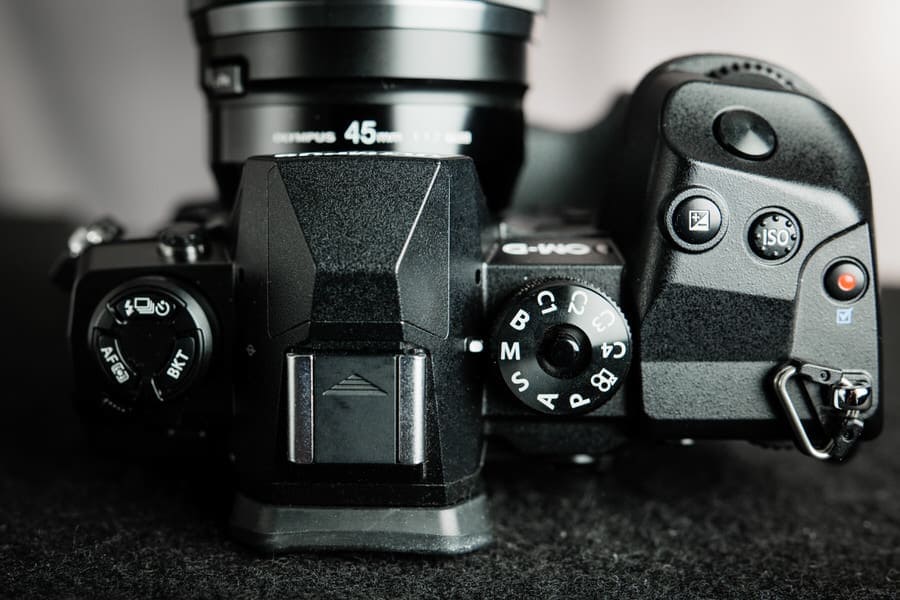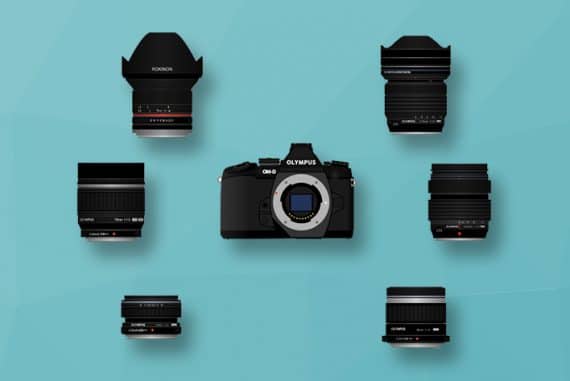
Olympus OMD EM1 X Review
If you're looking for a robust and powerful flagship camera that's packed full of unique features, don't miss this Olympus OMD EM1 X review!
The Olympus OMD EM1 X is the co-flagship body along with the Olympus OMD EM1 III from the 100-year-old imaging company.
This is a pro body in every regard with the built-in vertical grip, outstanding weather sealing and AI subject tracking.
If you shoot sports and long for a system with lenses and a camera body that is lightweight, but yet incredibly rugged, then this camera is for you. Ditto for wildlife photographers who use long telephoto lenses.

Features super-fast continuous shooting, excellent image stabilization, and an inbuilt vertical grip for comfortable shooting.
The camera also has unique features for landscape photographers as well.
The Olympus OMD EM1 X is also a great option for portrait photographers such as myself as you will see below.
I will be reviewing the camera mostly from this perspective.
Table of Contents
Olympus OMD EM1 X Specs
- Ergonomics and button placement
- Long battery life
- Top of the line weather sealing
- Best in class IBIS
- Unique features (Intelligent Subject Tracking / Live ND)
- Portability
- 400k shutter rating
- Outdated EVF and LCD
- No sensor improvements from previous models
- Outdated video specs
- Pixels – 20.4 Megapixel
- ISO Sensitivity – Auto, 200 to 25600 (Extended: 64 to 25600)
- Shutter Speed – Mechanical: 1/8000 to 60 Seconds / Electronic: 1/32000 to 60 Seconds
1 to 30 Minutes in Bulb Mode - Autofocus Points – Phase Detection: 121 (121 Cross-Type)
Contrast Detection: 121 - Memory – Dual Slot: SD/SDHC/SDXC (UHS-II)
- GPS – Yes
Build & Appearance

The flagship Olympus OMD EM1 X camera body.
The Olympus OMD EM1 X was one of those cameras that broke the internet upon release. It was deemed a huge and heavy camera that defeated the premise of the m4/3 system of lightweight bodies and lenses.
From Olympus’ promotional images, users’ images, and even my own right here in this review, I can see why people thought that. I want to assure you that when in hand, it is very lightweight and not as large as it looks.
I own a Nikon D5 and the Olympus OMD EM1 X is nowhere near the size and weight of that camera or other bodies with an integrated grip. Like that body and the Canon 1DX III, this Olympus camera is tough as nails and built to withstand the elements.
It’s pretty rare that a camera company is so confident in their weather sealing that they will list the IPX1 waterproof rating.
If you are planning a trip to capture Alaskan wildlife or cacti in the blowing desert sand, this is the camera to bring.
Where the camera falls down is the EVF at 2.36 million dots and back LCD screen at 1 million dots. By today’s standards, this is very low.
The EVF does have a large 0.83 magnifications and a fast 120 refresh rate (great for action photography), but this reuse from the company’s other cameras appears to be a cost-cutting measure.
You would think the flagship would outshine the lower end cameras in the lineup and be on par with other brands, but this is not the case.
Don’t get me wrong, these shortcomings don’t mean you cannot achieve great images. However, for someone like me who has an eye to the viewfinder for sometimes 12 hours at a wedding, eye relief is welcoming.
Ergonomics & Handling

Close up of the top panel of the Olympus OMD EM1 X.
The Olympus OMD EM1 X is simply a joy to hold. I teach a basic camera class in my local area so I get to hold many different brands and bodies.
This camera is the most comfortable camera body I have ever held and that is no exaggeration. It feels great in hand and all controls are right where they should be.
The attention to detail such as putting raised rivets on the ISO button for the ability to find a commonly used setting without taking one’s eye from the viewfinder should be applauded. The grip is deep and comfortable to hold.
When in vertical mode all the controls such as a joystick, AF ON button, etc. are in the same place as the horizontal position. This is definitely one of those camera designs that will let you easily operate the camera by feel and memory.
This professional camera has no scene modes or auto function on the mode dial. If you rely on these methods for shooting, the lower end models such as the Olympus OMD EM5 III will be more to your liking.

The unique battery sled of the Olympus OMD EM1 X.
The battery door is quite unique as it is a sled design making for easy battery swapping.
The Olympus OMD EM1 X also features USB-C in-camera charging.
This is a welcome trend in cameras allowing us to charge via our computers, cell phone charging bricks or simply plugging into a wall outlet.
Focus Performance

Olympus OMD EM1 X + Olympus 45mm f/1.2 | 1/2500 at f/1.2 ISO 200
The Olympus OMD EM1 X has two processors inside making for lightning-quick autofocus. The joystick is one of the best I’ve used and moves quickly and also diagonally for placing an autofocus point exactly where you want them.
The eye/face detect is good, but not class-leading. Olympus regularly updates firmware for their cameras and this being the flagship body I think they may include the new and improved eye AF in the near future.
The AF does not falter in low light and the tracking AF is really good making this system the choice for sports photographers like Kelley Cox from USA Today among others. All 121 focus points are cross-type, practically guaranteeing accuracy.
Some may consider a camera like this merely for action, but I think wedding photographers could make good use of it as well. The long-lasting battery life, lightning-fast AF, and effortless handling is perfect for covering events.
Low Light Performance

Olympus OMD EM1 X + Olympus 40-150mm f/2.8 | 1/100 at f/2.8 ISO 1600
The Olympus OMD EM1 X has the same sensor as it’s little brother the OMD EM1 III and low light performance is exactly the same as far as noise.
However, the AF felt a tad quicker in low light than other Olympus cameras and this may have something to with the dual processors inside this body.
As with all Micro Four Thirds sensor cameras, the way to get clean results at high ISO’s is nailing your exposure so as to not have to boost in post and using ultra-fast lenses such as the Olympus 25mm F/1.2 Pro Lens.
Some like to limit the ISO to 1600 max, but I feel ISO 3200 looks good and I’m willing to take it to ISO 6400 with some noise reduction software applied.
The noise is very film-like and not bothersome to my eyes although color fidelity can become an issue above ISO 6400.
Image Quality

Olympus OMD EM1 X + Olympus 45mm f/1.8 | 1/60 at f/1.8 ISO 200
The image quality of the Olympus OMD EM1 X is excellent in-studio and out. Olympus does a great job with skin tones and this camera is no exception.
The in-body image stabilization in this camera is simply incredible at 7.5 stops when combined with one of the Olympus IS equipped lenses like the Olympus 12-100 F/4 Pro Lens. With a lens without IS, a very respectable 6.5 stops can be had.
This best in class stabilization is critical for handheld telephoto photography or night time cityscapes and will enable you to leave the tripod at home.

Olympus OMD EM1 X + Olympus 45mm f/1.2 | 1/4000 at f/1.2 ISO 200
For portrait photography, I never missed in any of my shots in these two sessions when either employing eye AF or moving the focus point via joystick.
It’s a joy to simply direct your subject and not worry so much about the technical or having to overshoot.
Overall Performance

Olympus OMD EM1 X + Olympus 45mm f/1.2 | 1/3200 at f/1.2 ISO 200
The Olympus OMD EM1 X is all about speed. The camera shoots 15fps with a mechanical shutter and a mind-blowing 60fps with an electronic shutter and all in RAW.
So whether shooting planes, trains and automobiles…or runaway brides, you will have no issues.
The shutter sound is very dampened and I really don’t think I would ever need to do silent shooting with electronic shutter but that option is available.
While in the same category as a Sony A9II or Canon 1DX III, the Olympus OMD EM1 X is not going to give blackout-free shooting like the former, nor unlimited buffer like the latter.
However, you will get a lighter and smaller body that can track fast action nearly as well at a lower cost.
Other Useful Features

Live ND Mode – Olympus OMD EM1 X + Olympus 40 – 150mm f/2.8| 0/.5 at f/3.5 ISO 400
As is typical of Olympus, this camera is filled with unique features that are unlike anything else on the market. The Live ND filter can give you silky waterfalls (or in my case here, fog over a lake) in real-time while composing your shot.
This will let you leave physical filters out of your bag and enable you to get those silky waterfall photos with ease.
While I had no moving water in my area this winter, it did prove useful to achieve a spooky fog effect and I could see getting creative effects with this on people moving in a busy street.
Many cameras are doing pixel shifting these days to create high-resolution images from lower resolution sensors. These always require a tripod.
The Olympus OMD EM1 X is the first camera to allow handheld high-resolution images turning the normally 20mp image into an 80mp RAW file or 50mp JPEG enabling one to crop heavily, print large or do extensive editing.
The image stabilization is so good and the processors so fast that multiple images are combined seamlessly on the spot resulting in these high-resolution files.
The caveat is that your subjects must be reasonable still in order for this process to work without ghosting.
This feature will be great for product photographers, real estate photographers as well as landscape photographers in calm situations.
Another marquee feature is intelligent subject tracking of airplanes, trains and various motorsports like cars and motorcycles. Simply select which subject you want to be tracked in the menu, compose your shots, and fire away.
Within the viewfinder, you will see your subjects automatically tracked with a box around them. This camera is begging for more subjects to be installed either via a free or paid firmware update.
I could definitely see Olympus having a service in which one paid a nominal fee to have certain subject tracking installed as their AI gets more advanced. I’d love to see brides, various types of animals, birds, children, etc. added in over time.
Value for Money

The Olympus OMD EM1 X with the swivel screen tilted outwards.
If the special features of this camera excite you along with having a built-in vertical grip, superior ergonomics and weather sealing, then the price of about $2600 is certainly worth it.
This is a professional grade body rated at 400,000 shutter actuations that will last for years to come.
The potential with firmware upgrades here is enormous and Olympus would be smart to do this as free and/or paid upgrades.
If you are a wedding and portrait shooter like I am, the camera is worth it for the long battery life and incredible customizability with a gazillion buttons leaving menu diving a thing of the past.
This is the best feeling camera in the hand I’ve ever touched and this is especially important on long shooting days.
Sports shooters will find that not only are telephoto lenses for the system smaller and lighter in weight than their full-frame counterparts, they are also significantly cheaper as well.
Olympus OMD EM1 X Review | Conclusion
I first saw the Olympus OMD EM1 X at a camera store touch and try event and while I was impressed with the ergonomics of the camera right away, I was put off by the sub-par EVF and back screen compared to other modern mirrorless cameras.
For long wedding days, taking away eye strain was important to me.
So while my fellow photographers at the event marveled at how this camera could further their shooting of sports, wildlife, landscape and the like, I felt it wasn’t worth it to jump from the co-flagship Olympus OMD EM1 III.
I’ve since come around on this camera as a tool for wedding photography after one of my second shooters picked one up.
While slightly bigger and heavier than other cameras in the micro four-thirds system, the great feel of the camera with all its buttons perfectly in place really won me over. It’s a joy to shoot.
I surely hope Olympus will launch a Mark II version sooner rather than later with a more modern EVF and an updated sensor as well. They certainly nailed the ergonomics without question.

Features super-fast continuous shooting, excellent image stabilization, and an inbuilt vertical grip for comfortable shooting.













